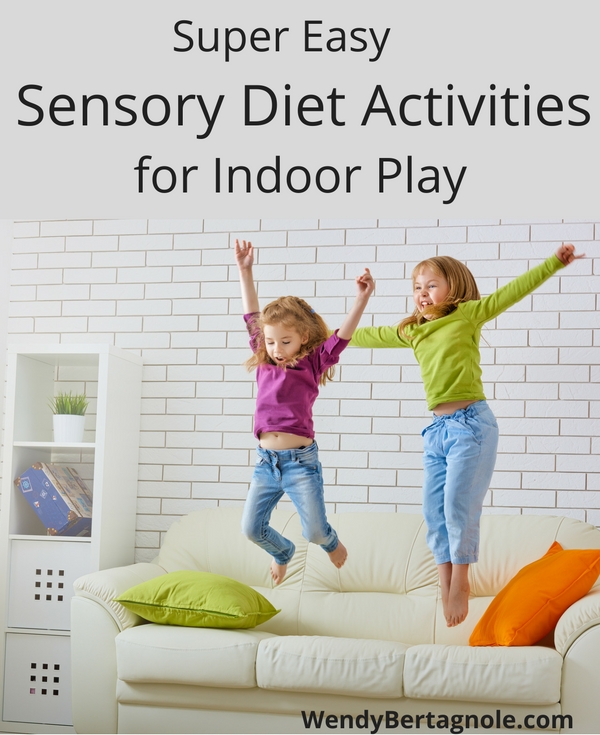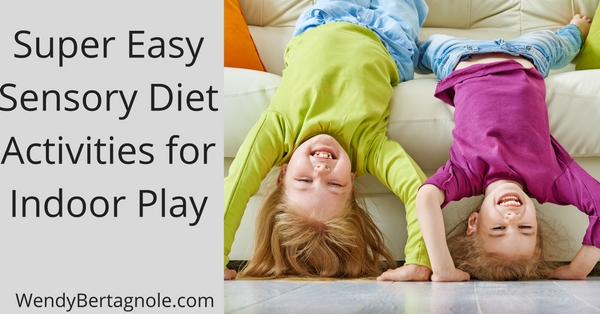Indoor Sensory Diet Activities when Outside Play Isn’t an Option
The winter and cool Spring months can feel long… really long!
If you live in a place like I do, the summer provides great time for the kids to go outdoors and be active, but between the rain, the cold, and the slushy snow of the winter months, we have more inside time than outside time.
If you are like me and have active kids, all that inside time creates a problem. A big problem.
While some kids might be content to sit and read, color, or play quietly during the winter months, my kids won’t go for that for more than an hour or so.
With more inside time comes more irritable kids, less patience for all of us, and all of that is a recipe for a disaster.
Most kids’ sensory systems need a lot of sensory input on a daily basis, which is hard during the winter months.
In our home we’ve become creative with our indoor sensory diet activities for the winter months to keep crankiness at bay and make our indoor days a bit more tolerable.
Want more sensory ideas? Be sure to check out our other fun sensory activities for kids!

What Is A Sensory Diet?
I like food. I really like food actually, but here’s the thing.
If I’m not careful, the food I eat can do more harm that good.
My body doesn’t like dairy or gluten much and when I ignore that preference, I tend to be more irritable, and feel “off” for a while afterwards.
To help my body function the way it should, to keep me from being too irritable and cranky, I choose to stay away from certain foods and ingest more of other things I know my body prefers.
Some people would call this a “diet” but for me it is a way of life, a way of being aware of what my body needs and staying away from those things that does it harm.
My body isn’t like other people’s, though.
My husband could eat dairy all day and never feel sick or irritable like I do.
His body has different preferences, so his diet looks a bit different from mine.
A sensory diet is much the same.
Just as every person has to eat to function, every living being needs sensory stimulation to function optimally as well.
And, just as the types of food a body can take in varies from person to person, so too does the types of sensory activities a person needs.
While one person may like mushy food, while others might gag at the texture.
Some people might love the feeling of walking around barefoot on various surfaces while others prefer the comfort of wearing socks and shoes to avoid feeling all the different textures.
Some people can tolerate a lot of noise while other’s cant.
Needing more of one thing is called sensory seeking, while staying away or not tolerating something is called a sensory aversion.
We all have a different set of sensory needs and aversions, and likely we unconsciously adapt our daily routines to fill those sensory needs.
The process of adapting the day to fill sensory preferences and avoid those aversions is called a sensory diet.
Just as we all have regular meals with food specific to our bodies’ preferences, we also all have regular sensory activities specific to our sensory preferences and aversions.

Indoor Sensory Diet Play
For children this happens mostly through play.
Now when I think back to my own days of growing up, I didn’t have access to video games, and hundreds of entertaining cartoon shows at my fingertips, so my days were spent mostly outdoors.
I, like most people my age, spent my days outside exploring, wandering, creating, running, chasing, and everything else I could think of.
My body was constantly working which naturally filled my sensory needs.
Kids today don’t always have access to that same kind of play, so we have to create it to keep their sensory systems from going haywire.
Knowing which activities your child needs and how to know which ones to avoid can feel confusing without a knowledge of your child’s unique sensory system.
To keep this simple, we will go over some of the most calming and most versatile sensory diet activities for indoor play.
Proprioceptive Sensory Diet Activities
While the word “proprioceptive” can look intimidating, don’t let the size of it scare you away because these activities are like the powerhouse activities for a sensory diet to keep kids calm and happy.
Proprioception involves movement.
Any kind of pushing, pulling, vibrating, or stimulating the joints will activate the proprioceptive sense.
While those are all easy to do outside, inside proprioceptive activities can be a bit more challenging.
Some of my favorite and easy to do are the following;
- Making couch cushion towers and body slamming them to knock them over
- Make a next of pillows and blankets then jump onto them
- Jump on the bed or couch (there are limits to what can happen while jumping to protect them from getting hurt)
- Pretend to be monsters and stomp up the stairs
- Pretend to be bunnies and hop from room to room
- Have a wrestle match (safely of course)
- Play a game of sardines
- Have an indoor snowball fight
- Roll a kid up in a blanket and squeeze them like a burrito for a few seconds
- Play a game of tag, hide and seek, or freeze tag
- Make an obstacle course with chairs, couches, and other furniture. Crawl over, under, and around it all in a timed race
Vestibular Sensory Diet Activities
The vestibular sense is another one that may seem foreign, but is fairly simple to understand.
It involves any kind of balance or movement of the body in space (like jumping, spinning, swinging, hanging upside down) will all activate the vestibular sense.
Some kids will have vestibular aversions, and will prefer to avoid these activities.
That is ok and should never be forced (that would be similar to forcing you to eat a food that makes you want to vomit… it’s just not a good idea).
For those who crave this kind of sensory diet activity, some of my favorites are:
- Ring around the rosies
- Spin in place for a few seconds
- Hold a child by the hands and spin them around
- Practice yoga together
- Try a handstand against the wall
- Do a backbend
- Jump from couch to couch like superman
- Lay flat in the bathtub and float
- Spin in an office chair
- Rock in a rocking chair
Tactile Sensory Diet Activities
The tactile sense is one you probably are familiar with but likely don’t realize how vast it is in every day sensory diet activities that occur naturally in the home.
The tactile sense is activated any time any portion of the body touches something.
For those who have a child with tactile aversions, activities such as getting dressed, combing hair, clipping nails, and playing with anything messy will be a lot more difficult.
As with all aversions, it is best to not force those and if necessary, speak with an occupational therapist about ways to help your child work through them.
(If that isn’t an option, check out the sensory solutions course where parents are guided through the complete process of addressing a child’s sensory needs at home).
Some of my favorite tactile activities are;
- Make home made playdoh to play with
- Place small toys in a tub of dry rice or beans and dig them out
- Finger paint
- Help prep food for dinner (the more they can use their hands instead of a utensil the better it will be)
- Walk around barefoot
- Play with different sensory bins
- Help fold, sort, or put away laundry
- Help clean (I use baking soda and all natural cleaners when cleaning so I don’t have to worry about them handling chemicals)
Making it All Work
Just as my way of eating is something I choose to do to keep my body functioning like it should, the sensory activities we do during the day is a choice we make to keep our sensory systems balanced and our emotions more regulated.
If I approach my food preferences like a restrictive diet with strict schedules, rigid routines, and large restrictions, it never lasts long.
The stress of having to maintain such strict guidelines gets to me quicker than anything else and I end up “falling off the bandwagon” as so many yo-yo dieters do.
For that reason, I don’t follow a strict food diet.
I listen to my body, I eat what feels right and I mostly avoid the things that make my body feel upset.
My approach to a sensory diet is the same.
While it is important to keep the sensory systems regulated so we don’t drive each other crazy during the long winter months of indoor play, I don’t force things, I don’t follow strict schedules, and I allow my kids to have opportunities to listen to their bodies and do what they feel they need.
Sometimes that means bending some common household rules.
If the end result is happier, more regulated kids, I’m happy to bend rules all day long so our winter months don’t feel as long and grueling as they otherwise would.
How do you do indoor sensory diet activities?
About the Guest Author
This post originally appeared on WendyBertagnole.com and is reprinted with permission.
With an undergraduate degree in child development, and a master’s degree in special education, this foundation was a springboard for Wendy in helping kids and families to see the root of any challenges they face.
